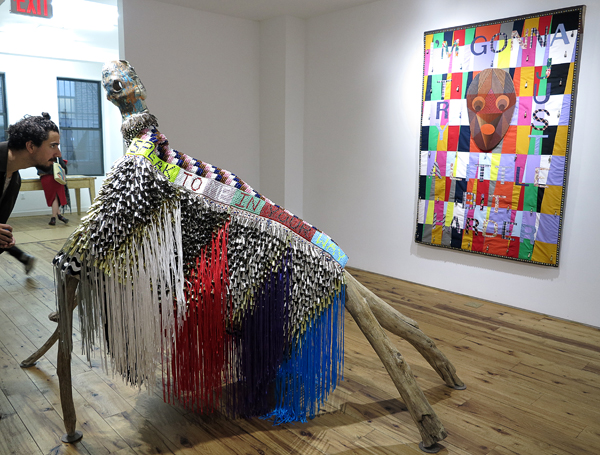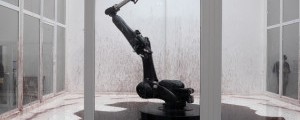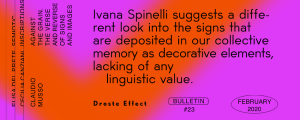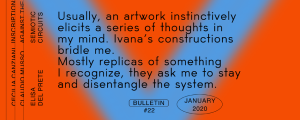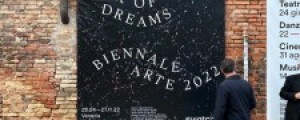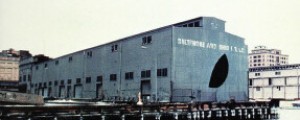Jeffrey Gibson at MARC STRAUS Gallery, New York
MARC STRAUS Gallery, New York presents its third one-person exhibition of work by Jeffrey Gibson. Gibson creates sculptures and paintings that intermingle more traditional Native American art with contemporary art and culture. Half Choctaw and half Cherokee, he uses techniques and materials that are traditional to Native American culture, and elaborates them through his profoundly personal process. Gibson’s artwork incorporates references to contemporary American culture that are personal to the artist, such as evocative objects and pop song lyrics integrated into the artwork.
In the upstairs main exhibition room, a series of highly adorned punching bags are surrounded by beaded wall hangings – referencing materials and textiles used in traditional Native American clothing, such as, respectively, dancing costumes and robes. Despite the decorations, the punching bags are still recognizable, and retain a strong reference to that pugilistic world. These as well as the wall hangings are strong expression of a lush, vivid identity, and incorporate text that represents personal political statements. In these and other works, Gibson appropriates phrases from social movements to express immediate issues.

Jeffrey Gibson, repurposed punching bags (2015) at Marc Straus Gallery, New York. Photo © Matilde Soligno
This embodiment of contrasts is conveyed also by Jeffrey Gibson’s new series of monochromatic paintings on rawhide. Document 2015, on show at MARC STRAUS Gallery, is the mesmerizing presence of a deer hide, painted with geometric shapes, hanging from the wall of the small room upstairs. The contrast between softly painted but precise abstractions and this translucent treated skin accentuates the deer hide’s materiality – and ultimately gives it a voice. Another immediate, intimate necessity: acknowledging its presence, as the living creature it once was.
By using wool, steel studs, glass beads, artificial sinew, metal jingles, wood, copper cones, and other materials of different origin, not only has he addressed the history of craft in Native American everyday life, but the globalization of trade that invested the production of these materials.
The artist’s contribution to his heritage is in its own way a development of this craft, and belongs to the realm of Native American craftsmanship as well as to contemporary art.

Jeffrey Gibson at Marc Straus Gallery
left: repurposed punching bags
right: IN TIME WE COULD HAVE BEEN SO MUCH MORE (2015)
Photo © Matilde Soligno

IN TIME WE COULD HAVE BEEN SO MUCH MORE (detail) 2015
Wool, steel studs, glass beads, artificial sinew, metal jingles, canvas, wood
Photo © Matilde Soligno
On Sunday, October 25, Marc Straus hosted a talk addressing the significance of Text & Craft in Contemporary Art. Panelists were Sara Reisman (Artistic Director and Curator at The Rubin Foundation), Glenn Adamson (Nanette L. Laitman Director, Museum of Arts and Design), and John Lukavic (Curator at Denver Art Museum).
The discussion revolved around Native American art representation in the contemporary art world, proposing a critical view of common conceptions of minority art practices, and addressed the work of Jeffrey Gibson, who answered questions from the panelists and the public.
Sara Reisman, who chaired the panel discussion, opened by proposing the term ‘decorative conceptual’ to define conceptual art that is well crafted, where artisanal diligence and dedication are still defining points. She introduced concepts that were then developed by all panelists, such as spiritualism as a key element in the experience of art in general.
The relationship between craft and contemporary art was the main subject of the talk. Glenn Adamson highlighted common conceptions of art and craft, where craft is generally regarded as “traditional” and “necessary,” while art is anti-traditional and unhinged from functionality. In this view, the artist is driven by ideas, while craft is driven by necessity. This conception comes with a stigma towards craft, considered a lower endeavor – as reflected by the power relation existing between artist and fabricator (e.g. the artist’s assistant). The power relationship between contemporary art and craft retraces privilege in society, as craft is in fact generally associated with women and minorities. As a consequence, craft lies mostly outside of contemporary art, both positively and negatively. Adamson stressed the importance of process and technique in the realization of an artwork. He supports an empowerment of craft, back to its Germanic etymology – «Kraft» means «power» – as craft is in his view the most relevant factor to realize an idea.
John Lukavic questioned Western categorization of culture by bringing the example of the term «pop art», that he jokingly defined as «racist», because it assumes that all people share the same reality, which is obviously not the case. At the same time, «tradition» is a «lazy term», because it doesn’t reflect the changing nature of cultural practices throughout history and individuals. While detailing some of the craftsmanship amongst Native Americans, Lukavic raised the topic of the availability of materials (one of the «necessities» of craft), that nowadays is bound to international trade. In fact, in Jeffrey Gibson’s artwork some of the traditional cones are printed in Taiwan – another tile in Gibson’s sociopolitical undercurrent. Using text in artwork as Gibson does has roots in traditional culture, and has been extensively used by artists to convey political content. In addition, Lukavic denounced the underrepresentation of American Indian artists in the contemporary art world.
Jeffrey Gibson then answered questions to help define the connections between his personal experience as a minority and queer artist and his artwork. He talked about music as a key element in his personal experience, always there to underly important emotional passages of his life as a young artist struggling with marginalization, largely due to his belonging to a minority both for his ethnicity and his sexual orientation. Pop song musicians (e.g. Boy George) became his elders, a referral point to look up to, their music the only way to cope and not feel confined. Their lyrics became mantras that he incorporated in his artwork. He talked about the disruption of Native American communities by a government program designed to relocate them from their original home to urban areas and cities. He mentioned his work in counseling and around the issues connected with Native American identity. He hinted to the ideas behind his punching bag series, recalling that the inspiration for his first adorned punching bag was from an old photograph of a figure made of sheets, built by an institutionalized patient. For Gibson, appropriation is a way of having and giving a voice, a practice that is reflected in his whole production.
The talk ended with gallerist Marc Straus reciting a poem of his own writing, inspired by the artwork of Jeffrey Gibson.
Jeffrey Gibson is on show at MARC STRAUS Gallery, New York through December 13, 2015
by Matilde Soligno
in Focus on the American East
Oct 28, 2015





